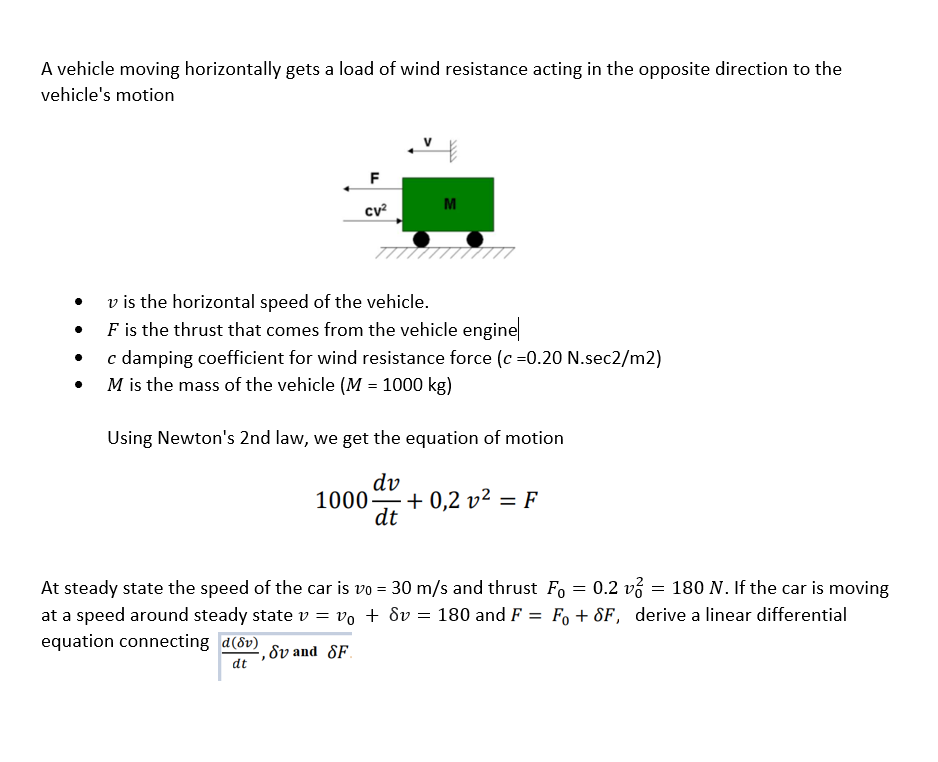A vehicle moving horizontally gets a load of wind resistance acting in the opposite direction to the vehicle's motion M cv TTTTTI77 v is the horizontal speed of the vehicle. F is the thrust that comes from the vehicle engine c damping coefficient for wind resistance force (c =0.20 N.sec2/m2) M is the mass of the vehicle (M = 1000 kg) Using Newton's 2nd law, we get the equation of motion dv 1000 + 0,2 v² = F dt At steady state the speed of the car is vo = 30 m/s and thrust F, = 0.2 v3 = 180 N. If the car is moving at a speed around steady state v = vo + dv = 180 and F = Fo + 8F, derive a linear differential equation connecting d(&v) ,8v and 8F dt
A vehicle moving horizontally gets a load of wind resistance acting in the opposite direction to the vehicle's motion M cv TTTTTI77 v is the horizontal speed of the vehicle. F is the thrust that comes from the vehicle engine c damping coefficient for wind resistance force (c =0.20 N.sec2/m2) M is the mass of the vehicle (M = 1000 kg) Using Newton's 2nd law, we get the equation of motion dv 1000 + 0,2 v² = F dt At steady state the speed of the car is vo = 30 m/s and thrust F, = 0.2 v3 = 180 N. If the car is moving at a speed around steady state v = vo + dv = 180 and F = Fo + 8F, derive a linear differential equation connecting d(&v) ,8v and 8F dt
International Edition---engineering Mechanics: Statics, 4th Edition
4th Edition
ISBN:9781305501607
Author:Andrew Pytel And Jaan Kiusalaas
Publisher:Andrew Pytel And Jaan Kiusalaas
Chapter1: Introduction To Statics
Section: Chapter Questions
Problem 1.12P: A differential equation encountered in the vibration of beams is d4ydx4=2D where x = distance...
Related questions
Question
100%

Transcribed Image Text:A vehicle moving horizontally gets a load of wind resistance acting in the opposite direction to the
vehicle's motion
F
M
cv?
v is the horizontal speed of the vehicle.
F is the thrust that comes from the vehicle engine
c damping coefficient for wind resistance force (c =0.20 N.sec2/m2)
M is the mass of the vehicle (M = 1000 kg)
Using Newton's 2nd law, we get the equation of motion
dv
1000-
+ 0,2 v² = F
dt
At steady state the speed of the car is vo = 30 m/s and thrust F, = 0.2 v3 = 180 N. If the car is moving
at a speed around steady state v = vo + dv = 180 and F = F, + 8F, derive a linear differential
equation connecting d(dv)
,8v and SF.
dt
Expert Solution
This question has been solved!
Explore an expertly crafted, step-by-step solution for a thorough understanding of key concepts.
Step by step
Solved in 2 steps with 5 images

Knowledge Booster
Learn more about
Need a deep-dive on the concept behind this application? Look no further. Learn more about this topic, mechanical-engineering and related others by exploring similar questions and additional content below.Recommended textbooks for you

International Edition---engineering Mechanics: St…
Mechanical Engineering
ISBN:
9781305501607
Author:
Andrew Pytel And Jaan Kiusalaas
Publisher:
CENGAGE L

International Edition---engineering Mechanics: St…
Mechanical Engineering
ISBN:
9781305501607
Author:
Andrew Pytel And Jaan Kiusalaas
Publisher:
CENGAGE L